Birds come in all shapes and sizes, from tiny hummingbirds to tall ostriches.
One of the most distinguishing features across bird species is the length of their legs in proportion to their bodies.
Long-legged birds have captured our fascination and can be found across diverse habitats, including lakes, beaches, grasslands, and wetlands.
Their elongated legs serve important functions, whether wading through water to catch fish, running across open terrain at high speeds, or reaching high up in trees.
In this article, we’ll highlight some of the most notable and recognizable long-legged birds worldwide.
We’ll explore how flamingos, cranes, herons, and others use their lengthy legs to their advantage for survival.
From the spindly thin legs of a marbled godwit to the thick, strong ones of an ostrich, these specialized legs equip each bird for a particular lifestyle.
Read on to learn more about ten birds with some of the most impressive leg-to-body ratios in the avian world.
Birds With Long Legs
Flamingos
Known for their spindly legs and pink plumage, flamingos are one of the most distinctly long-legged birds.
Their thin legs can be longer than their entire body, measuring up to 60 inches long.
Flamingos’ lengthy legs enable them to wade through shallow lakes and wetlands to feed.
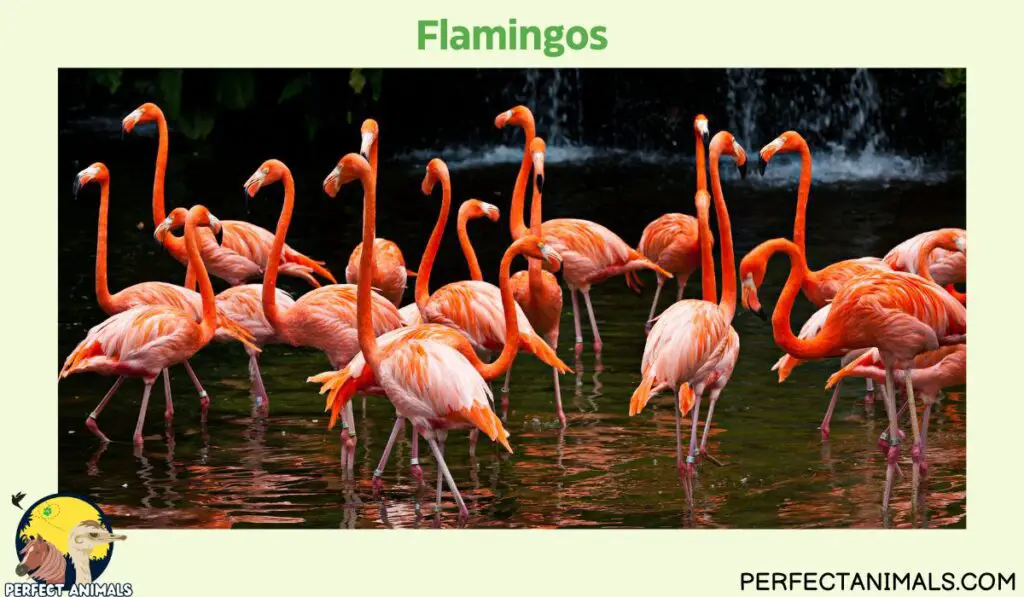
They use their long necks to plunge their heads upside down to filter-feed, while their legs keep the rest of their bodies above water.
Their lanky legs also provide flamingos with better reach to access more fish, shrimp, and algae low in the water.
Flamingos’ legs must support their large bodies and serve as their only means of standing since flamingos do not nest or perch in trees.
Their specialized anatomy makes flamingos well-equipped for their wetland lifestyle.
Related Article – 18 Amazing Animals With Long Necks
Cranes
Cranes are elegantly long-legged, standing anywhere from three to six feet tall.
15 species of cranes exist, most within the Gruidae bird family.
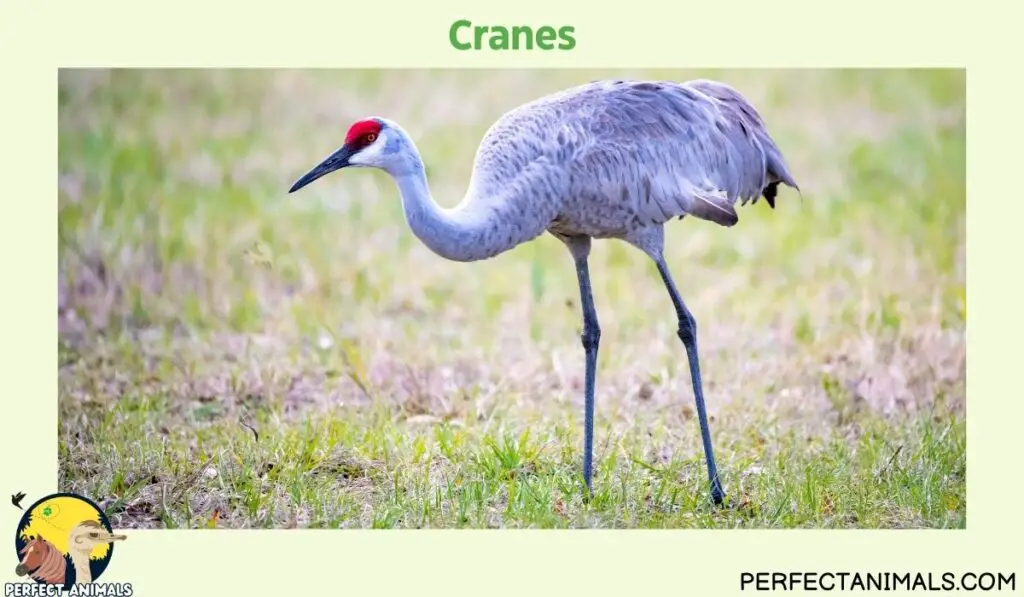
Their legs comprise half their vertical height or more.
Cranes often inhabit marshes and plains, employing their long legs to wade through vegetation and water to catch fish, amphibians, and other prey.
Their stilt-like legs provide excellent balance and allow them to see over tall grasses to spot threats while grounded.
Cranes frequently run swiftly and are capable sprinters over open land thanks to their elongated lower limbs.
Many crane species are threatened or endangered today due to habitat loss.
But their adaptive long legs equip them for survival in their natural environments.
Herons
This common aquatic bird family (Ardeidae) contains over 60 species sporting long legs suited for wading.
Great blue herons and great egrets are two of the most widespread herons boasting legs measuring 15 inches from their knees down.
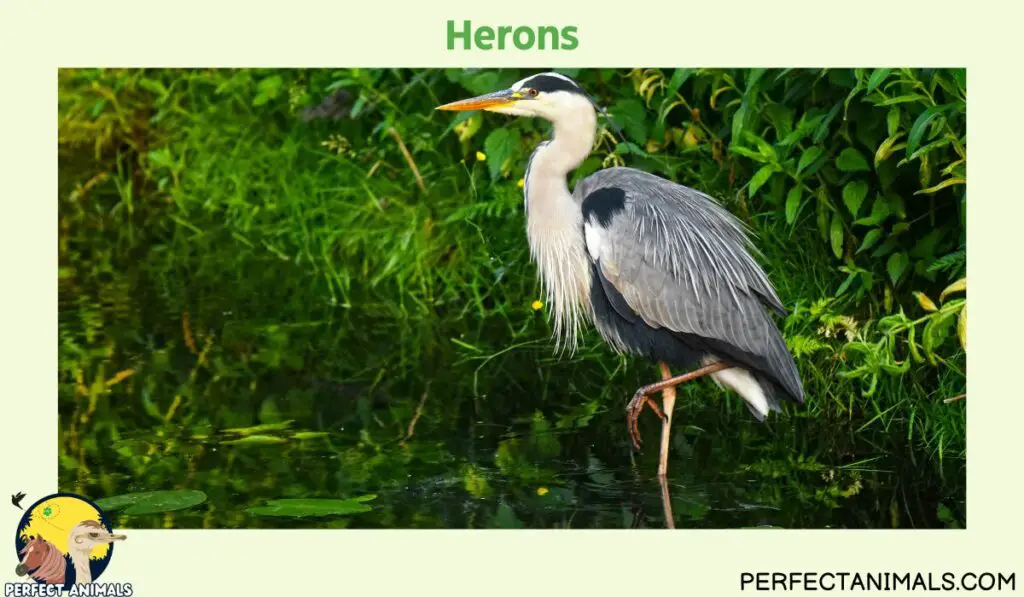
Herons have s-shaped necks and dagger-like bills to strike and grasp fish and amphibians from water or land using their lengthy legs for stealthy steps through marshes.
The legs of herons safely elevate them away from soggy terrain that other wildlife could not traverse.
Their tall, spindly legs serve as the perfect foundation for ascending flight to travel to new feeding grounds.
Herons retract their long necks while flying, with their lengthy legs trailing behind towards their short tails.
The heron’s anatomy displays fascinating balance and agility.
You May Also Like – 9 Owls of Illinois
Storks
Storks are large, long-legged wading birds best recognized for their characteristic plumage and size.
White storks stand nearly 4 feet tall, while marabou and saddle-billed storks reach up to 5 feet tall thanks to their lengthy legs alone measuring up to 12-24 inches long.
Storks inhabit marshlands and grasslands across Europe, Asia, Africa, and South America.
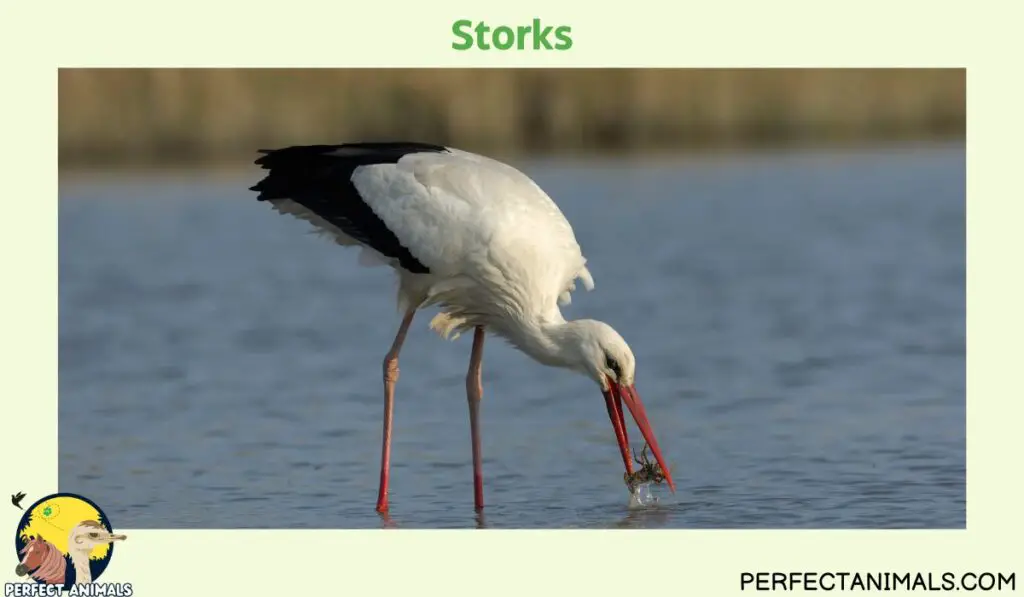
They keep their balance using their long tails during otherwise ungainly movements on land with their lengthy legs lifting their bodies high above the ground.
Storks’ long legs provide excellent reach allowing them to catch and consume amphibians, insects, rodents, reptiles, and over 25 species of fish while wading through depths up to 16 inches.
Their boldly colored bills also snap quickly thanks to their elevated vantage point from their outstretched legs to hunt prey.
Ostriches
As the largest living bird species, ostriches also have the longest and most powerfully thick legs of any bird, with thighs measuring about 16 inches in diameter.
Their legs make up nearly 60 percent of their average 6-9 foot height.
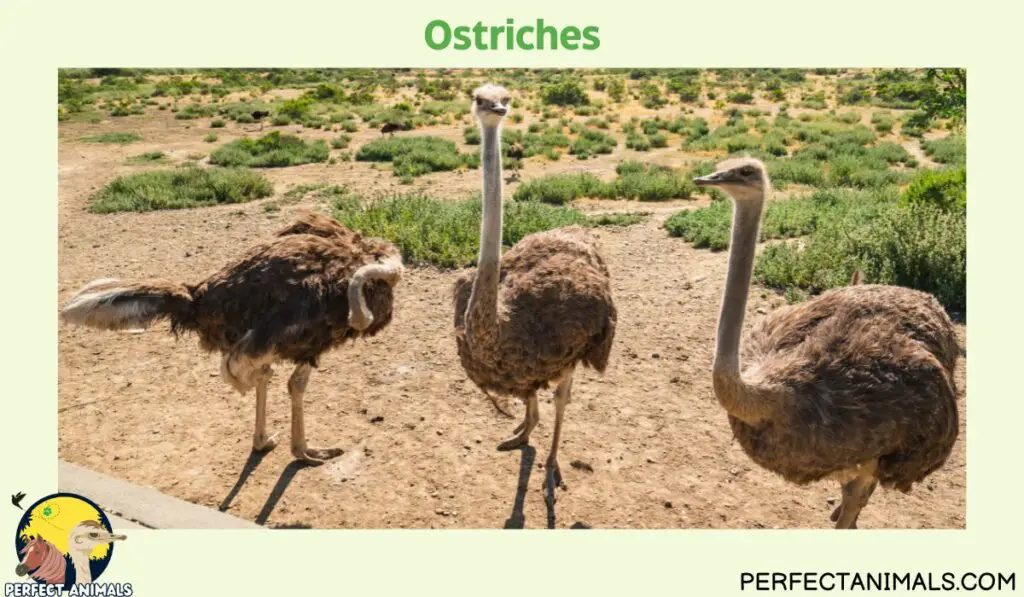
Native to the savannas and deserts of Africa, ostriches are flightless but are equipped to cover 10-15 feet in a single stride at speeds over 40 miles per hour.
Their strong legs aid their sprinting, maneuverability, and kicking for self-defense using their sharp claws.
Ostriches employ their height from their extra long legs to spot predators like lions from far reaches of open terrain.
The incredible muscular legs of ostriches significantly aid their survival, from powerful jogging to sitting and laying their camouflaged eggs in nests dug in dirt using their feet.
You May Also Like – 12 Clever Birds That Eat Spiders
Emus
Emus sport lengthy legs with thick, three-toed feet enabling these large flightless birds to stand at least 5 feet tall.
Native to Australia, emus wander vast grassy woodlands and outback grazing on plants, fruits, and insects they can easily spot and access from their elevated stature thanks to their long-legged build.
An emu’s long thick legs comprise over 60 percent of its total body height.

Emus survive by running at speeds over 30 miles per hour using their strong legs to escape threats, only kicking out with dangerous claws if confronted.
Their durable legs carry them effortlessly for long distances migrating and provide balance and agility even with their lanky necks and small vestigial wings.
The emu’s hardy legs are central to its thriving in Australia’s varied habitats.
Egrets
Egrets are a common type of heron identifiable by their bright white plumage, long S-shaped necks, and equally lengthy legs aiding their fishing and foraging lifestyle.
The legs of great egrets and cattle egrets, for example, stretch around 15 inches long while these slender birds stand up to three feet tall completely.

Their thin yellow legs account for at least half of their vertical height.
An egret’s spindly legs allow it to silently prowl through shallow water environments from marshes to mangroves stalking small prey.
Their legs provide balance and stealth as they stand motionless waiting to spearfish and amphibians with their sharp beaks.
An egret flies strongly with its neck tucked and legs extended behind.
And its legs become a perch to flatten breeding plumes for attracting mates.
The dainty egret legs belie their strength supporting these birds’ adaptability across many wetland habitats.
Related Article – Top 10 Birds With Long Beaks
Secretary Birds
This distinct raptor bird of prey native to sub-Saharan Africa stands nearly four feet tall.
Its elongated legs alone reach some three feet, unlike other birds of prey.
Secretary birds thrive chasing down terrestrial snakes, lizards, birds, eggs, and small mammals darting through grasslands and savannas.

Whacking their prey with their feet until killed, secretary birds can keep jumping and kicking while barely breaking stride thanks to their specialized legs.
Their sturdy legs aid in running at 20 miles per hour over great distances while spotting prey.
Secretary birds also use their lengthy legs during fierce stomping and kicking territorial displays.
Standing prominently atop their lengthy legs signals their far-reaching vision guarding against threats.
Unique amongst raptors, the secretary bird’s leg structure matches its preference for chasing down prey on foot.
You May Also Like – Animals With Curly Horns
Avocets
This medium-sized wading bird populates marshes and estuaries boasting some of the lengthiest legs relative to its plump body.
Avocets measure about 18 inches long overall, but their delicate blue-gray legs stretch nearly five additional inches for more than half their body length.

Avocets sweep these lengthy legs methodically through shallow waters feeling out food like aquatic insects, crustaceans and fish often submerged out of reach to other birds.
The avocet keeps its feathers dry this way using its specialized legs as tools to sense food below without submerging its wings and body.
When facing threats, avocets can also escape rapidly running across mudflats and still waters where most other species bog down but not the avocet with its remarkably lissome legs carrying it effortlessly weightlessly it seems.
Ibises
About two dozen species exist in the ibis bird family Threskiornithidae, all sharing especially long legs relative to their white, black, or scarlet-mottled bodies.
Sacred ibises frequent marshlands and mudflats with legs reaching up to 14 inches long to support over two feet of total bird height.
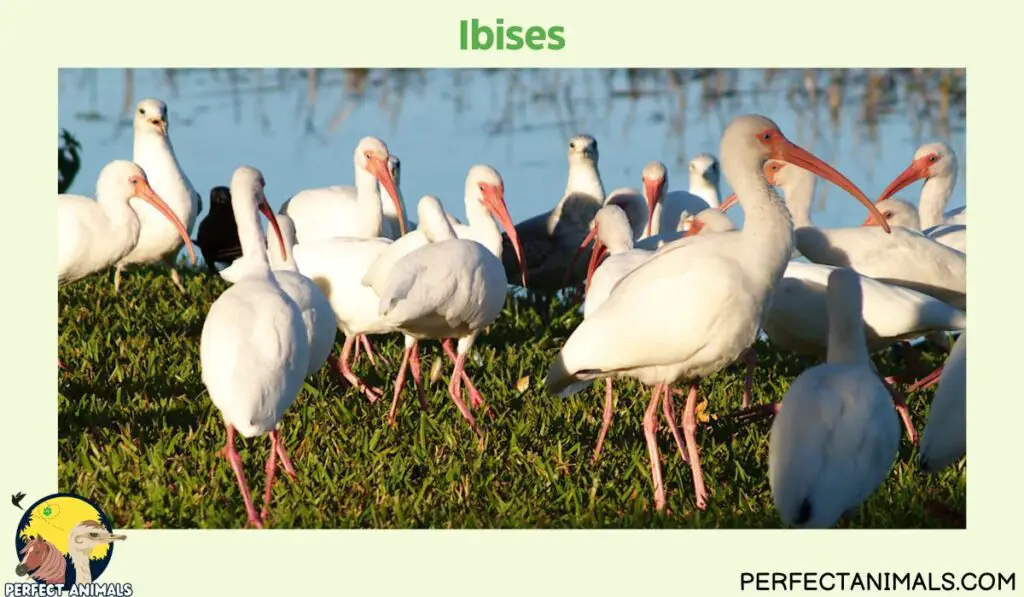
An ibis’ slender legs contain little muscle but allow it to walk steadily on soft terrain unsuitable for many other types of birds.
Ibises wade slowly and methodically in these soggy areas probing their curved beaks into the mud searching by touch for crustaceans, amphibians, small fish, and more.
An ibis in flight stretches its thin legs trailing far beyond its short tail feathers as an identifiable long-legged silhouette.
Foraging lifestyle demands adapted the ibis’ lengthy lower limb anatomy over time to support its survival.
Final Thoughts
Birds display an incredible diversity of leg lengths and types to suit their species’ needs.
As we have seen, birds with the longest legs relative to their bodies inhabit lakes, marshes, plains, and beaches across the world.
From the subtle elegance of an avocet’s slim legs to the formidable thickness of an ostrich’s, these elongated lower limbs have evolved for good reason.
The birds we have covered flaunt legs that makeup half their vertical height or more in many cases.
Their legs allow them to easily wade through depths of water and vegetation to catch aquatic prey as herons and ibises do.
Lengthy legs let Secretary Birds and ostriches scan wide grassland vistas spotting predators and prey while enabling them to sprint at high speeds when needed.
Cranes’ and flamingos’ stilt-like legs provide excellent balance and leverage to stand motionless for long periods, whether wary of threats or filter-feeding upside-down.
While not all birds possess exceptionally long legs, these unique animal species demonstrate how lengthened lower limbs can provide great advantages.
They allow birds to access resources that shorter-legged creatures cannot while aiding their movement and speed to escape danger quickly.
So while a bird’s legs may seem like a humdrum body part compared to stunning feathers or wings, they offer birds incredible survival benefits in the diverse ecosystems they inhabit.
Resources – (for further reading)
Wikipedia – Flamingo | Crane (bird) | Heron | ibis | Egret
Britannica – Stork | Migratory Bird, Nesting Habits & Diet | Britannica
Britannica – Secretary bird | African, Predator, Raptor

John Maloney, a passionate bird enthusiast since his childhood, has cultivated expertise in bird care and habitat conservation. Holding an MS in Wildlife Biology from the University of Florida, John has conducted significant research on endangered bird species and their ecosystems.

